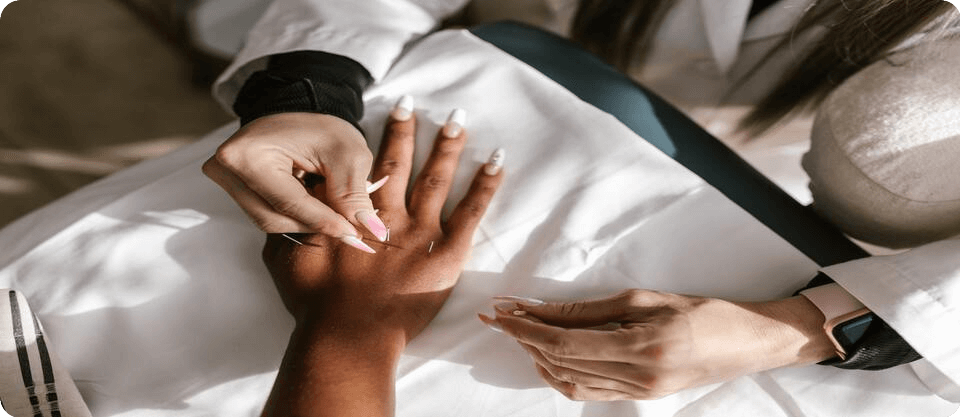
Acupuncture for 5 different types of pain
Acupuncture is an ancient Chinese practice dating back almost 3000 years, and is still used today for many reasons. A lot of people use it to relieve pain, assist with overall wellness and stress relief or even to stop smoking.
We are going to explore acupuncture a bit more by looking at:
What is acupuncture?
Acupuncture is a technique that is used to balance the flow of energy, or life force through the meridians of the body. This energy is referred to as chi or qi (pronounced chi).
A trained professional will use a very fine-tipped needle and insert it at one of the 361 acupuncture points in the body, which is mostly used to relieve pain, and in more recent years, for overall wellness and stress relief.
How does acupuncture work
When there is a blockage in the meridians or pathways, it results in the interruption in the flow of energy throughout the body and presents as an illness.
Meridians are accessible through 361 acupuncture points, and when a needle is inserted into the appropriate point, it brings the energy back into balance. Sometimes some of the points may be in a completely different place to the area where the pain is being experienced.
In ancient Chinese medicine, the body consists of 12 meridians that connect to specific organs in the body, or networks of organs, which assist in internal communication throughout the body. Meridians begin in the fingertips, the most sensory areas of the body, and connect to the brain, and then connect to the associated organ in that meridian. Internal and external health is achieved when qi flows through the meridians without any blockages, allowing it to nourish all the organs and systems of the body, giving a feeling of well-being, renewed energy, health, and balance.
Each acupuncturist has their style of performing acupuncture, which blends Eastern and Western approaches to medicine. An Eastern approach incorporates the body as a whole, rather than just treating symptoms. Western medicine is a more modern approach and prescribes medication to treat an illness in the body.
In general, each treatment can take between 20 and 60 minutes, and the frequency of treatments will depend on the severity and location of the pain. Commonly, it involves 1 – 2 sessions per week, for a single complaint, and 3- 4 weeks of treatment should be sufficient (based on 2 sessions per week, a total of 8-12 sessions should target the pain).
A treatment involves:
- Inserting a needle at a corresponding point in the body, and at various depths. It should not be painful when the needles are inserted, however, slight discomfort or tingling may be experienced. Once the needle reaches the correct depth and the pressure point, a mild ache might be felt. Treatment can use between 5 and 20 needles at any time.
- Once the needle is inserted, it may need to be slightly moved, manipulated, or twisted. Heat or electrical pulses may also be included in treatment. A person will lie still and relax while the needles are hard at work.
- Once the treatment is complete, the needles will be removed. Again, this should not cause any pain.
Once treatment is complete, a person will feel relaxed or completely re-energised.
Is acupuncture good for pain
Because acupuncture does not produce immediate results, it is often hard to determine if it is effective in the treatment of pain. There is evidence that acupuncture works better in people who believe in the power of healing through complementary therapies.
Because acupuncture is a low-risk treatment, with very minimal side effects, it is ideal to try if having trouble with persistent pain and getting no relief from conventional methods.
By inserting needles into points in the body, the nervous system is stimulated, and this in turn will relieve pain.
Risks of acupuncture
No matter what type of therapy one seeks to treat pain, it comes with side effects and risks, and acupuncture is no exception. Before undertaking any therapy, one should always seek medical advice.
Bleeding, bruising, or pain can occur when the needle is inserted or removed.
An infection could result if needles that are used are unsterilised. All needles should be single-use needles. It is best to watch the acupuncturist remove the needles from the packaging.
Injuries could result from the incorrect placement of needles.
Acupuncture benefits
Acupuncture is paramount to traditional Chinese medicine, and the fact that it is still widely used today proves its effectiveness in treating the body in pain and illness and promoting relaxation and wellness to the body.
By bringing about internal balance to the body, we can reduce the likelihood of the symptoms of illness developing any further.
Because acupuncture is an alternate therapy, it can be combined with other therapies to target many health concerns at one time.
Acupuncture has proven to reduce stress and the effects of stress on the body, which are often contributing factors to pain.
Acupuncture for 5 different types of pain
1. Acupuncture for back pain
In today’s world, people spend a lot more time working on laptops, cell phones and computers. Because of the fast-paced world we live in, most people carry heavy loads on their backs, or in a sling bag over their shoulders. This can lead to poor posture and constant back pain. Acupuncture can bring about pain relief and reduce inflammation in the joints.
2. Acupuncture for neck pain
Neck pain is closely linked to back pain. Studies have shown that acupuncture for neck pain temporarily relieves pain, however, the effects are not long-lasting.
Closely linked to pain is stress, and because acupuncture helps to reduce stress on the body, this can affect pain associated with the neck.
3. Acupuncture for knee pain
Pain, inflammation, and stiffness in the knee can be caused primarily by osteoarthritis. This causes a decreased range of movement in the knee, and pain when going about daily activities.
Acupuncture has an anti-inflammatory effect on the knee, reducing inflammation, and pain, and ultimately improving flexibility. It has also been noted that acupuncture releases natural pain-relieving chemicals in the body.
4. Acupuncture for headaches
Headaches have been treated using acupuncture for thousands of years. Because of the effects of acupuncture on the body, and the relief from stress, it has a remarkable improvement in the duration and intensity of headaches.
5. Acupuncture for shoulder pain
Similar to knee pain, shoulder pain can be caused by a condition like osteoarthritis, or other conditions like frozen shoulder or tendinitis. This results in pain, inflammation, and a limit on the range of motion in the shoulder and the arm.
Not only will acupuncture help relieve the pain, but it will also reduce the swelling and inflammation, and influence the range of motion of the shoulder joint.
Conclusion
While acupuncture is an amazing treatment to include when suffering from pain, it is important to keep in mind that acupuncture should never replace treatment by a physician and should be used as a complementary therapy. Acupuncture also does not work for every person, and if it is done for a few weeks with no relief from pain, it might not be the right treatment.
Interested in alternative therapies? Check out our Alternative and Holistic Therapies Course.



